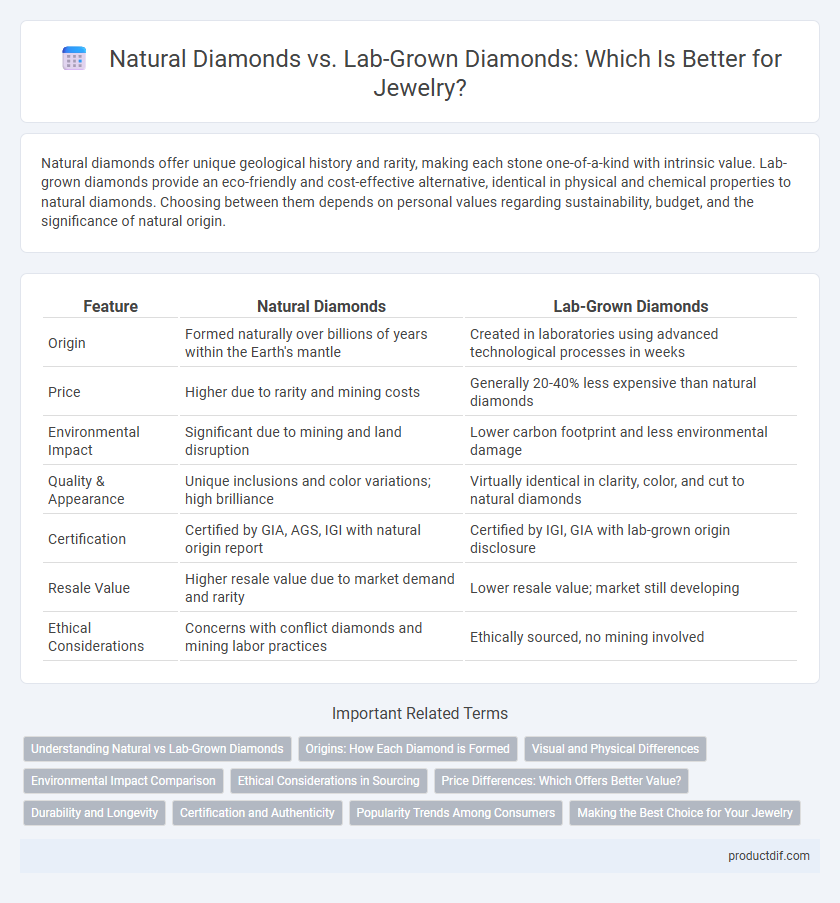Natural diamonds offer unique geological history and rarity, making each stone one-of-a-kind with intrinsic value. Lab-grown diamonds provide an eco-friendly and cost-effective alternative, identical in physical and chemical properties to natural diamonds. Choosing between them depends on personal values regarding sustainability, budget, and the significance of natural origin.
Table of Comparison
| Feature | Natural Diamonds | Lab-Grown Diamonds |
|---|---|---|
| Origin | Formed naturally over billions of years within the Earth's mantle | Created in laboratories using advanced technological processes in weeks |
| Price | Higher due to rarity and mining costs | Generally 20-40% less expensive than natural diamonds |
| Environmental Impact | Significant due to mining and land disruption | Lower carbon footprint and less environmental damage |
| Quality & Appearance | Unique inclusions and color variations; high brilliance | Virtually identical in clarity, color, and cut to natural diamonds |
| Certification | Certified by GIA, AGS, IGI with natural origin report | Certified by IGI, GIA with lab-grown origin disclosure |
| Resale Value | Higher resale value due to market demand and rarity | Lower resale value; market still developing |
| Ethical Considerations | Concerns with conflict diamonds and mining labor practices | Ethically sourced, no mining involved |
Understanding Natural vs Lab-Grown Diamonds
Natural diamonds form over billions of years deep within the Earth's mantle, characterized by unique geological conditions that create unparalleled optical properties and inherent rarity. Lab-grown diamonds, produced through advanced technological processes like Chemical Vapor Deposition (CVD) or High Pressure High Temperature (HPHT), offer identical chemical composition and physical characteristics but with greater affordability and environmental benefits. Understanding these distinctions helps consumers make informed decisions about value, origin, and sustainability in the jewelry market.
Origins: How Each Diamond is Formed
Natural diamonds form deep within the Earth's mantle over billions of years under intense heat and pressure, undergoing a slow carbon crystallization process. Lab-grown diamonds, also called synthetic or cultured diamonds, are created in controlled laboratory environments using advanced methods such as High Pressure High Temperature (HPHT) or Chemical Vapor Deposition (CVD). These manufacturing techniques replicate the natural crystallization process but produce diamonds in weeks rather than millennia, ensuring identical physical and chemical properties.
Visual and Physical Differences
Natural diamonds exhibit unique inclusions and slight color variations due to their formation over billions of years, creating subtle differences in clarity and hue that lab-grown diamonds may lack. Lab-grown diamonds typically display higher clarity and fewer impurities, with uniform color consistency achieved through controlled processes. Although both types share the same physical properties--such as hardness and refractive index--the presence of growth patterns visible under magnification can help differentiate natural from lab-grown diamonds.
Environmental Impact Comparison
Natural diamonds require extensive mining processes that lead to significant land disturbance, habitat destruction, and carbon emissions, contributing to environmental degradation. In contrast, lab-grown diamonds are produced using controlled technological methods that consume less water and energy, resulting in a smaller carbon footprint and reduced ecological harm. Choosing lab-grown diamonds supports sustainability by minimizing the negative environmental impact associated with traditional diamond mining.
Ethical Considerations in Sourcing
Natural diamonds often carry concerns related to unethical mining practices, including environmental damage and human rights violations in conflict regions. Lab-grown diamonds offer a more sustainable alternative by minimizing ecological impact and ensuring transparency in origin. Ethical sourcing of lab-grown diamonds aligns with consumer demand for responsible luxury and promotes fair labor standards throughout the supply chain.
Price Differences: Which Offers Better Value?
Natural diamonds typically command higher prices due to their rarity and the extensive mining process involved, with average costs ranging from $3,000 to $7,000 per carat depending on quality. Lab-grown diamonds, produced through advanced technological methods like Chemical Vapor Deposition (CVD) or High Pressure High Temperature (HPHT), are generally 30-40% less expensive while offering the same physical, chemical, and optical properties as natural diamonds. For buyers prioritizing budget and ethical sourcing, lab-grown diamonds present better value without compromising on brilliance or durability.
Durability and Longevity
Natural diamonds possess exceptional hardness, rated 10 on the Mohs scale, ensuring unparalleled durability and resistance to scratches and abrasions. Lab-grown diamonds share nearly identical chemical and physical properties with natural diamonds, providing comparable longevity and structural integrity for everyday wear. Both types maintain their brilliance and structural stability over time, making them excellent choices for long-lasting jewelry.
Certification and Authenticity
Natural diamonds undergo rigorous certification by established gemological laboratories such as GIA and AGS, ensuring verified authenticity and origin. Lab-grown diamonds receive certifications from reputable entities like IGI and GCAL, confirming their composition and ethical sourcing. Both types come with detailed grading reports that guarantee transparency in quality, clarity, and carat weight for consumers.
Popularity Trends Among Consumers
Natural diamonds maintain enduring popularity due to their rarity, historical value, and emotional significance in engagement rings and luxury jewelry. Lab-grown diamonds are rapidly gaining consumer preference, especially among younger buyers, thanks to their affordability, ethical sourcing, and environmental benefits. Market reports indicate a steady annual growth rate of around 15% in lab-grown diamond sales, reflecting shifting trends toward sustainable and cost-effective jewelry options.
Making the Best Choice for Your Jewelry
Natural diamonds, formed over billions of years deep within the Earth, offer unmatched rarity and unique inclusions that enhance their value in fine jewelry. Lab-grown diamonds, created using advanced technological processes like High Pressure High Temperature (HPHT) or Chemical Vapor Deposition (CVD), provide a sustainable and cost-effective alternative with identical physical and chemical properties. Choosing between natural and lab-grown diamonds depends on factors such as budget, ethical considerations, and personal preference for environmental impact or provenance authenticity.
Natural diamonds vs lab-grown diamonds Infographic

 productdif.com
productdif.com